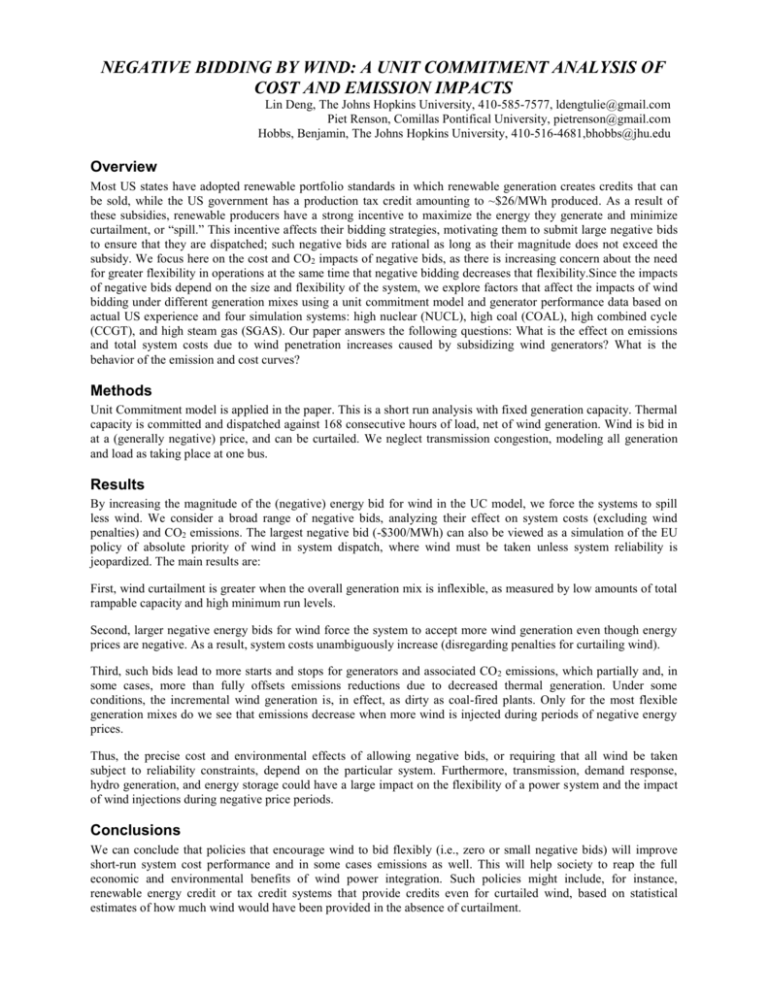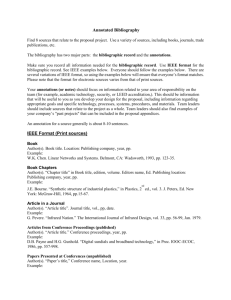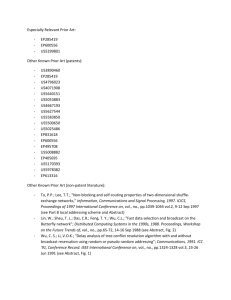Overview - United States Association for Energy Economics
advertisement

NEGATIVE BIDDING BY WIND: A UNIT COMMITMENT ANALYSIS OF COST AND EMISSION IMPACTS Lin Deng, The Johns Hopkins University, 410-585-7577, ldengtulie@gmail.com Piet Renson, Comillas Pontifical University, pietrenson@gmail.com Hobbs, Benjamin, The Johns Hopkins University, 410-516-4681,bhobbs@jhu.edu Overview Most US states have adopted renewable portfolio standards in which renewable generation creates credits that can be sold, while the US government has a production tax credit amounting to ~$26/MWh produced. As a result of these subsidies, renewable producers have a strong incentive to maximize the energy they generate and minimize curtailment, or “spill.” This incentive affects their bidding strategies, motivating them to submit large negative bids to ensure that they are dispatched; such negative bids are rational as long as their magnitude does not exceed the subsidy. We focus here on the cost and CO2 impacts of negative bids, as there is increasing concern about the need for greater flexibility in operations at the same time that negative bidding decreases that flexibility.Since the impacts of negative bids depend on the size and flexibility of the system, we explore factors that affect the impacts of wind bidding under different generation mixes using a unit commitment model and generator performance data based on actual US experience and four simulation systems: high nuclear (NUCL), high coal (COAL), high combined cycle (CCGT), and high steam gas (SGAS). Our paper answers the following questions: What is the effect on emissions and total system costs due to wind penetration increases caused by subsidizing wind generators? What is the behavior of the emission and cost curves? Methods Unit Commitment model is applied in the paper. This is a short run analysis with fixed generation capacity. Thermal capacity is committed and dispatched against 168 consecutive hours of load, net of wind generation. Wind is bid in at a (generally negative) price, and can be curtailed. We neglect transmission congestion, modeling all generation and load as taking place at one bus. Results By increasing the magnitude of the (negative) energy bid for wind in the UC model, we force the systems to spill less wind. We consider a broad range of negative bids, analyzing their effect on system costs (excluding wind penalties) and CO2 emissions. The largest negative bid (-$300/MWh) can also be viewed as a simulation of the EU policy of absolute priority of wind in system dispatch, where wind must be taken unless system reliability is jeopardized. The main results are: First, wind curtailment is greater when the overall generation mix is inflexible, as measured by low amounts of total rampable capacity and high minimum run levels. Second, larger negative energy bids for wind force the system to accept more wind generation even though energy prices are negative. As a result, system costs unambiguously increase (disregarding penalties for curtailing wind). Third, such bids lead to more starts and stops for generators and associated CO 2 emissions, which partially and, in some cases, more than fully offsets emissions reductions due to decreased thermal generation. Under some conditions, the incremental wind generation is, in effect, as dirty as coal-fired plants. Only for the most flexible generation mixes do we see that emissions decrease when more wind is injected during periods of negative energy prices. Thus, the precise cost and environmental effects of allowing negative bids, or requiring that all wind be taken subject to reliability constraints, depend on the particular system. Furthermore, transmission, demand response, hydro generation, and energy storage could have a large impact on the flexibility of a power system and the impact of wind injections during negative price periods. Conclusions We can conclude that policies that encourage wind to bid flexibly (i.e., zero or small negative bids) short-run system cost performance and in some cases emissions as well. This will help society to economic and environmental benefits of wind power integration. Such policies might include, renewable energy credit or tax credit systems that provide credits even for curtailed wind, based estimates of how much wind would have been provided in the absence of curtailment. will improve reap the full for instance, on statistical References E. Alishahi, M. P. Moghaddam and K. M. Sheikh-El-Eslami, "An investigation on the impacts of regulatory interventions on wind power expansion in generation planning," Energy Policy, vol. 39, no. 8, p. 4614–4623, 2011. R. Barth, H. Brand, P. Meibom and C. Weber, "A Stochastic Unit-commitment Model for the Evaluation of the Impacts of Integration of Large Amounts of Intermittent Wind Power," in 9th International Conference on Probabilistic Methods Applied to Power Systems, Stockholm, 2006. K. Voorspools and W. D’haeseleer, "Impact assessment of using wind power," Solar Energy, vol. 80, no. 9, p. 1165–1178, 2006. H. Holttine and S. Tuhkanen, "The effect of wind power on CO 2 abatement in the Nordic Countries," Energy Policy, vol. 32, no. 14, p. 1639–1652, 2004. C.-L. Chen, T.-Y. Lee and R.-M. Jan, "Optimal wind-thermal coordination dispatch in isolated power systems with large integration of wind capacity," Energy Conversion and Management, vol. 47, no. 18-19, p. 3456–3472, 2006. B. C. Ummels, M. Gibescu, E. Pelgrum, W. L. Kling and A. J. Brand, "Impacts of Wind Power on Thermal Generation Unit Commitment and Dispatch," IEEE Transacions on Energy Conversion, vol. 22, no. 1, pp. 44-51, 2007. E. D. Delarue, P. J. Luickx and W. D. D’haeseleer, "The actual effect of wind power on overall electricity generation costs and CO2 emissions," Energy Conversion and Management, vol. 50, no. 6, p. 1450–1456, 2009. N. Troy, E. Denny and M. O’Malley, "Base-Load Cycling on a System With Significant Wind Penetration," IEEE Transactions on Power Systems, vol. 25, no. 2, pp. 1088 - 1097, 2010. E. Denny and M. O’Malley, "Quantifying the Total Net Benefits of Grid Integrated Wind," IEEE Transactions on Power Systems, vol. 22, no. 2, pp. 605 - 615 , 2007. H. Holttinen and J. Pedersen, "The effect of large scale wind power on a thermal system operation," in Proceeding of the 4th International Workshop on Large-Scale Integration of Wind Power and Transmission Networks for Offshore Wind Farms, Billund, 2003. R. Baldick, "The Generalized Unit Commitment Problem," IEEE Transactions on Power Systems, vol. 10, no. 1, pp. 465-475, 1995. G. B. Sheble and G. N. Fahd, "Unit commitment literature synopsis," IEEE Transactions on Power Systems, vol. 9, no. 1, pp. 128-135, 1994. C. De Jonghe, B. F. Hobbs and R. Belmans, "Value of Price Re-sponsive Load for Wind Integration in Unit Commitment," IEEE Trans-actions on Power Systems, vol. PP, no. 99, pp. 1-11, 2013. B. F. Hobbs, "Optimization methods for electric utility resource planning," European Journal of Operational Research, vol. 83, no. 1, p. 1–20, 1995. S. Takriti, J. R. Birge and E. Long, "A stochastic model for the unit commitment problem," IEEE Transactions on Power System, vol. 11, no. 3, pp. 1497-1508, 1996. J. S. Heslin and B. F. Hobbs, "A Probabilistic Production Costing Analysis of SO 2 Reduction Strategies for Ohio: Effectiveness, Costs, and Regional Economic Impacts," Journal of the Air & Waste Management Association, vol. 41, no. 7, pp. 956-966, 1991.





